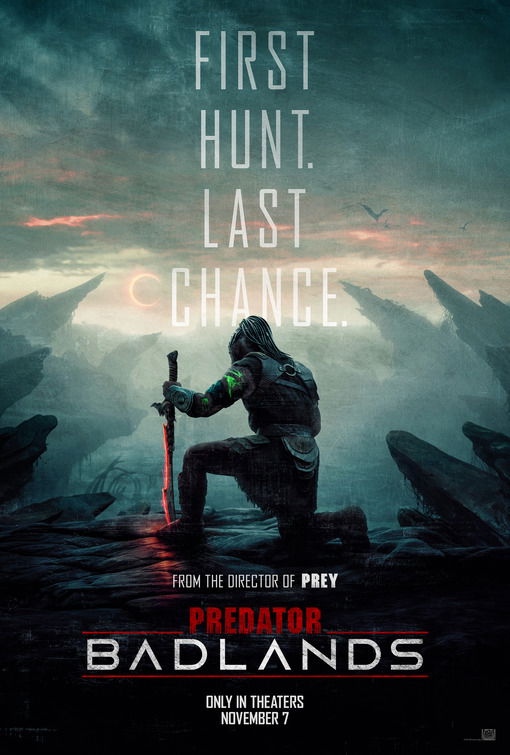Movie Reviews
Boy Kills World: Bill Skarsgard stars in blood-soaked thriller

2/5 stars
Exploding onto the screen like the bastard son of a dozen 1980s action movies and an arcade full of beat-’em-up video games, Boy Kills World is a whirl of blood-soaked martial arts and jet black humour that barely pauses for breath.
Over the course of two hours, Boy tears through the hierarchy of a near-future dystopia in the hopes of destroying the regal Van Der Koys, responsible for murdering his family.
The hook to Boy Kills World is that, because of his debilitated senses, Boy narrates his every waking moment through an incessant internal monologue, in a voice lifted from his favourite childhood video game, Super Dragon Punch Force 3.
Comedian and voice artist H. Jon Benjamin (Archer, Bob’s Burgers) provides Boy with the vocal identity for his relentlessly self-aware, comic-book-style voice-over.
Hilda Van Der Koy (Famke Janssen) rules with an iron fist, staging an annual “culling”, whereby a dozen enemies of the state are ceremonially executed in front of the people.
Such a fate befell Boy’s own mother and sister, and he has spent the years since living in hiding, honing his body into a lethal weapon under the brutal tutelage of Yayan Ruhian’s unforgiving Shaman.
Once Boy is set in motion, there is no stopping the swathe of bloody carnage he unleashes.
First-time writer-director Moritz Mohr shot the film in South Africa, which lends it a visually distinctive otherworldliness, but beyond this cosmetic exoticism, Boy Kills World ploughs a painfully familiar path.
Its sustained tone of fast-paced choreography, splashy violence and knowingly irreverent humour soon becomes exasperating, leaving it with no other option than to barrel towards a wholly predictable finale.

Skarsgard’s performance must be commended for its physicality, but ultimately Boy Kills World becomes as much of a physical ordeal to watch as for its hero to survive, and will surely prompt all but the most resilient of viewers to tap out long before justice is served.

Movie Reviews
Labyrinth Anime Film Review

Within the first few minutes of director Shōji Kawamori‘s Labyrinth, protagonist Shiori laments that “without smartphones, humanity would be doomed”. From the events that later transpire, I suspect Kawamori’s opinion is quite the opposite. Kawamori is, of course, best known for his lifetime of work on the Macross franchise, which features mecha battles, idol singers, and love triangles in most of its entries. If you squint a little, each of these main obsessions is also present in Labyrinth. It seems that Kawamori can’t help himself. Whether these elements mesh together to make a satisfying film is another matter entirely. Whereas his most beloved film, Super Dimension Fortress Macross: Do You Remember Love?, is a timeless classic, Labyrinth‘s reliance on modern tech and the anxieties around it almost instantly date it.
At the end of the screening, with my head in my hands, I sighed to myself, “How in hell’s name am I supposed to review this?” It’s a movie that almost defies explanation; any attempt to summarise the plot is likely to leave me gibbering incomprehensibly. I guess I’ll have to try. Suffice to say, Labyrinth is not by any means a “good” film. However, it’s certainly an entertaining one, and often (unintentionally) hilarious. Watching along with a highly engaged audience at the Scotland Loves Anime film festival was probably the best mode of experience for Labyrinth, for without my fellow cinemagoers’ stunned, disbelieving laughter, I doubt I would have survived to the end of its bloated, almost two-hour-long runtime.
Shiori is supposed to be the audience insert, an anxious high school girl who constantly apologizes for her mere existence. The daughter of a titanic judo instructor with the most impressively imposing moustache this side of Ivo Robotnik, she rejects her family’s focus on self-improvement via martial arts. Instead, she records social media videos with her female best friend Kirara. Their friendship is somewhat unequal – Kirara is far more outgoing and confident, and Shiori secretly seethes that her videos accrue far more “likes” from the faceless online masses. In fact, Shiori uses a secret, anonymous account to spew her negativity onto the internet rather than owning it as part of herself.
It’s this sublimated jealousy and insecurity that not only fractures their friendship but also Shiori’s identity. When her beloved smartphone screen cracks, it sends ruptures through her reality, as her persona splits in two – the more anxious version trapped within an almost Silent Hill-like alternative dimension, a shadowy analogue to the real world but empty of people, and a more confident “ideal” version that instantly becomes more outgoing. Ideal Shiori dons a VTuber-style two-tone wig and sets her sights on becoming a modern media superstar, the most popular Japanese high school girl, with a goal of garnering 100 million “likes.” She views her anxious alter ego as an impediment, and frequently taunts her through her apparently cloned smartphone, which seems to be able to dial its identical equivalent in the digital world, somehow without generating network errors.
We mostly view the story through Anxious Shiori’s eyes. She journeys through a dark, ominous liminal space populated by the souls of others similarly sucked into the digital underworld, where they are transformed, unsettlingly, into the smartphone stickers that best approximate their personalities. Anxious Shiori herself tended to contribute to friend group chats mainly via stickers as a way to hide her true emotions, engaging only at a surface level. The constant demand for connectivity and reciprocal communication is shown to be exhausting and all-consuming; so, when Kirara completely disconnects and ghosts Shiori, she panics that maybe Kirara has also been sucked into this world and lost her soul. The only thing preventing Shiori from losing hers is that her smartphone remains charged. Yes, in Labyrinth all that stands between humanity and devolution into mute digital emoticons is the presence of a spare battery pack. I know that I can get anxious when out and about and running low on charge, but Labyrinth takes battery anxiety to the extreme.
Human souls are bound and pressed by enormous industrial devices that pound three-dimensional bodies into flat images, with reams of red digital text spewing from between heavy plates, clearly symbolising blood. It’s cool imagery that I wish the film had leaned into a little more heavily. If anything, the aesthetic is similar to the recent Hatsune Miku movie Colorful Stage, although with significantly less music, unfortunately.
Anxious Shiori meets Komori, a sad-looking pink bunny sticker person who seems to know a lot about this world – the eventual reveal of his true identity is probably meant to be a huge shock, but I guessed it instantly. It’s not the most subtly plotted of films. Komori is quite fun, especially when he becomes so hapless and useless that Shiori has to attach a dog collar and string to drag him around behind her, floating like a balloon and bumping into things.
If it wasn’t already deranged, Labyrinth‘s central plot goes full batshit insane later on, with the evil mastermind Suguru Kagami planning to “liberate everyone’s ideal selves,” and it’s up to Anxious Shiori and Komori to try to prevent this… somehow.
Aesthetically, the film has its moments, especially in the digital underworld that acts as a dark mirror to our own. Unfortunately, all of the character animation is accomplished using 3D CG, which, while it does a reasonable job of emulating 2D animation, lacks any real-life authenticity. The characters move like dolls rather than real, living, breathing characters. There’s something about the natural exaggeration of movement, such as squashing and stretching, and other techniques often employed in traditional animation that bring life to character movement, which is all but absent. Yes, there’s some reasonably amusing slapstick here and there, and funny character expressions, but it’s a far cry from the verve and atmosphere of Kawamori’s previous works.
For much of Labyrinth, the festival audience sat in silence until some of the nuttier plot decisions were met with incredulous guffaws. Mostly, the film plays itself very straight, which is odd for a story featuring a floating pink bunny character and an evil music producer who wants to rule the world. One particular scene where Kagami takes Ideal Shiori to his bedroom and begins to suggestively unzip his tracksuit top was met with hysterical audience laughter that will become obvious if you see the film.
Multiple similar examples litter Labyrinth, and it’s hard to tell if these insane choices that trigger such hilarity are deliberate or not, and that’s why the film is so hard to rate. None of the pieces fit together properly. Anxious Shiori, for most of the film, is a fairly unengaging, dull protagonist, though her fake/ideal version is much more fun, which is probably the point. Kagami makes for a somewhat underwhelming villain, with an unclear plan that seems overly convoluted. The rules of the world seem to change upon the writer’s whim, and crazy stuff happens mostly out of nowhere. It’s like a laundry list of bonkers ideas all strung together without any coherent plan.
I found Labyrinth a struggle to endure, yet found certain aspects very entertaining. Perhaps my mistake was watching it stone cold sober. As one of my fellow festival attendees noted, it’s probably best viewed with at least a few beers on board already. I certainly can’t unreservedly recommend Labyrinth, but if you’re hankering for some good old “WTF am I even watching right now?”, then Labyrinth has you covered.
Movie Reviews
PREDATOR: BADLANDS Review

Dominant Worldview and Other Worldview Content/Elements:
Very strong moral worldview, with some redemptive qualities, teaches that protecting the weak elevates and ennobles the soul, and aids in one’s survival and defeat of evil, and the movie also promotes compassion, empathy, helping others, and equipping the weak to survive, but two parental figures in the movie are evil and heartless, but the hero tries to appease his evil father and gain his approval, despite his father’s rejection;
Foul Language:
No foul language;
Violence:
Strong and light, sometimes scary, violence such as predator alien murders his older son because he refuses to kill his younger and weaker brother (the Predator society is based on Spartan-type values regarding hunting and war), evil father tries to kill the other son but the older brother pre-prepared his spaceship to take the younger brother to another planet to earn their clan’s hunting initiation status, younger brother crash lands and fights off vicious vines, younger brother finds human female android who helps him survive the planet’s dangers, she helps him survive plant seeds that explode and put other creatures to sleep before eating them, she helps him kill a large alien animal for food, they have to survive grass that’s sharp as knives, they discover and eventually befriend a small creature who helps them in the hunt, younger brother fights large alien creature with rows of vicious-looking teeth and an ability to regenerate in hopes of capturing said creature and earning him the right to become a respected member of his clan, younger brother and female android battle evil heartless androids of large corporation that wants to use the younger brother to develop weapons and other useful items for people and wants to do the same thing with the large alien creature and its regeneration abilities he’s hunting, a big fighting sequence occurs near the movie’s end, followed by another life and death fight, and android robot bodies are smashed or torn apart or beheaded, characters are impaled or partially exploded using small fiery worm creatures;
Sex:
No sex;
Nudity:
No nudity;
Alcohol Use:
No alcohol use;
Smoking and/or Drug Use and Abuse:
No smoking or drugs (evil android puts good android to sleep by turning her off); and,
Miscellaneous Immorality:
A humanoid alien creature, the Predator in the movie title, has a disagreement with his evil father but he hopes to earn his father’s respect by hunting and capturing a large, awesome alien creature, but the evil father has decided that both his younger and elder son are too weak to survive, so can his mind be changed?
The movie opens with a brief written preface about the Predator race of aliens called the Yautja. The primary goal of these aliens is to hunt, and they hunt alone.
Cut to their home planet. Kwei is the larger older brother of Dek. Dek, the movie’s central character, is the runt of the litter in a clan that removes any sign of weakness. The Yautja think one weak link breaks the chain. Sadly, for Dek, that means he’s subjected to not just being ousted from the clan but being killed.
Kwei and Dek are arguing about Dek’s situation in Kwei’s spaceship. Unexpectedly, Kwei sympathizes with Dek, but warns him that his chances don’t look good, especially since their father already has rejected Dek. Dek chooses a lethal planet called Genna as his hunting ground. He also decides that, to gain their father’s approval and elevate his status, he will hunt a large and allegedly unkillable apex predator called the Kalisk. Kwei is not happy about that. He thinks the Kalisk will kill Dek because Dek is too weak. Dek replies, that, if he dies, which probably is likely, at least he will die with honor.
At that point, their gray-haired father appears. He’s angry and asks why Kwei didn’t kill Dek as he ordered to do. Kwei defies his heartless father. So, their father decides Kwei too must die because to forgive weakness is itself a sign of weakness. So, he tries to kill Kwei, but Kwei defends himself.
Meanwhile, Dek tries to help his brother, but Kwei shoves Dek back into his spaceship and closes the door on him. So, Dek watches helplessly from the ship while Kwei fights his father. Eventually, the father fatally wounds Kwei by thrusting his flaming sword through Kwei’s chest from behind. With his dying breath, Kwei activates his ship to send Dek to Genna.
Dek is knocked out by the spaceship’s sudden movement, and he wakes up on Genna. Immediately on exiting the ship, Dek encounters deadly brown vines that swing form the trees and try to kill and eat him. He fends them off with his blade and guns. A strange monkey-looking creature watches the fight and bonds with Dek. The creature is able to escape the vines by swinging through the trees, but he seems to help Dek fight them.
After fighting off the vines, Dek and the creature come to a clearing. They face new dangers, but get help from a damaged human-looking android, a female named Thia. Thia activates her translator and is able to understand Dek while he can understand her English. Her torso was severed from her robotic legs when she and her android companion, Tessa, encountered a Kalisk. She offers to take Dek to the creature’s lair if Dek will help her get back to Tessa, who disappeared during their fight with the creature. When Dek says he only hunts alone, Thia proposes that he think of her as a tool.
Dek agrees. So, with that, Dek and Thia establish a partnership, and the monkey creature, whom Thia names Bud, accompanies them.
Of course, getting to the Kalisk’s lair and capturing, or even killing the Kalisk is a very difficult proposition. Complications ensue when they come upon Thia’s twin android, Tessa. Thia’s twin decides that she and the androids under her leadership should serve the evil corporation that brought her and Thia to Genna. That means capturing the Kalisk and imprisoning Dek to take both of them to Earth for the company’s experiments and technology creation, including weapons creation.*
The odds are stacked against Dek, Thia and Bud. Will they survive and remain free?
PREDATOR: BADLANDS is a terrific science fiction thriller. It has excitement, thrills, heroic deeds, and lots of heart. Thia teaches Dek to be compassionate and empathetic. Meanwhile, the evil androids, including Tessa, are heartless automatons with not an ounce of sympathy. This conflict provides a marvelous, exhilarating contrast of good versus evil. Also, PREDATOR: BADLANDS has no foul or crude language and no explicit lewd or obscene content.
However, the movie does have lots of strong, action violence, scary moments, and scary creatures. The camera often cuts away from the more gruesome acts of violence, but it does show things like the father’s fiery blade exiting the older brother’s chest. Also, the good guys smash, crush, impale, and behead some of the heartless evil androids. Moreover, the predatory Yautja aliens are scary looking, as are the killer vines and the giant Kalisk monster. For instance, the Yautja have four large menacing teeth on the outside of their mouths, and the Kalisk has rows of scary teeth in its mouth plus a large scary dinosaur-like tail.
In addition, PREDATOR: BADLANDS shows that Dek and Kwei’s father is an evil alien who wants to kill his sons because they’ve disappointed him. Also, the computer program that the evil androids use is named MUTHR, like in the original ALIEN movie.* Thus, the movie’s two parental figures are evil and negative. So much for “honor thy father and mother.”
That said, PREDATOR: BADLANDS has a very strong moral worldview with some redemptive qualities. The movie teaches that protecting and equipping the weak ennobles and elevates the soul. It also aids in one’s survival and one’s triumph over evil.
MOVIEGUIDE® advises strong caution for the intense action violence and scary parts, characters and creatures in PREDATOR: BADLANDS.
* The evil corporation in PREDATOR: BADLANDS is the same as the one in the ALIEN movies, which originally ordered a heartless android to retrieve a dangerous alien specimen at the expense of the human crew of a spaceship called The Nostromo. 20th Century Fox, which is now owned by Disney, decided back in the 1990s to merge the ALIEN and PREDATOR franchises. In the ALIEN MOVIES, the company wanted to use the alien species to develop and sell new weapons, including bio-weapons. In PREDATOR: BADLANDS, the corporation also wants to use the large apex predator, the Kalisk’s, regeneration abilities to regenerate human body parts, including human and android soldiers, as part of the company’s medical and pharmaceutical division.
Movie Reviews
Jamie David Langland’s ‘THE CELLAR’ (2025) – Movie Review – PopHorror

Psychological thrillers have to be my least favorite genre of all time. Rarely does a movie get by on just dialogue before I give up. The Cellar started out as such, and I was getting ready to lose interest. As I got further, I learned to appreciate the film. It’s a tough call, but I was fully entertained by the story. I really should learn a lesson and sit through these types of films more often.
Let’s get into the review to find out my real feelings.
Synopsis
A young girl wakes up in a dim underground cell, with no memory of how she got there. As she fights to escape, sinister secrets resurface, blurring the line between reality and her own buried traumas.
The Rundown
This is what turns me off to psychological thrillers. The lines between reality and horror don’t quite fit in my humble opinion. Whether it hides behind a horror facade or just outright rushes a story to fit into a 90-minute film. The stories require a lot more time to explain without confusion. Everything becomes complex and a think piece instead of just plain enjoyment.
The Cellar is the film that made me second-guess all the movies I have ever written about, where I say there’s no love in reality, so horror movies are an escape for me. I like to be entertained, not just a lack of understanding. The film does move slowly, and sometimes it confuses you, but in the end, you can piece together the story. It becomes simplified as the movie progresses. It brings a sense of clarity.

Hello Darkness
The dark setting also gave the movie more “pop”. You would think a dark cellar is redundant; however, the film definitely becomes more interesting and eerie as we look past the characters and experience flashbacks. The film has almost a Silent Hill vibe when it comes to explanation. That isn’t a bad thing at all, seeing as I have a Silent Hill tattoo and a small obsession with the games.
This is honestly what I picked up on after about 20 minutes of the movie. It is almost as if the film is hard to piece together on purpose. The film is like a tapeworm slowly creeping into your brain. It stays there and takes over your mindfulness. The film makes you feel a certain level of paranoia because, of course, this story could easily be reality. We have always had a way of looking at extreme religious intent and walking away quietly due to their stature in the community.
In The End
I didn’t find too many problems with The Cellar. The director passed the test on the film. Though I was about to give up hope as usual, I am extremely glad I gave it a longer shot than most. I would have missed out on a great film if I had told myself it wasn’t my interest, and being ready to talk down the entire film. I can’t argue about the significance, and Jamie David Langland’s directorial debut is outstanding. I look forward to seeing more films under their name as time progresses.
-

 Milwaukee, WI1 week ago
Milwaukee, WI1 week agoLongtime anchor Shannon Sims is leaving Milwaukee’s WTMJ-TV (Channel 4)
-

 News1 week ago
News1 week agoWith food stamps set to dry up Nov. 1, SNAP recipients say they fear what’s next
-

 Culture1 week ago
Culture1 week agoVideo: Dissecting Three Stephen King Adaptations
-

 Seattle, WA1 week ago
Seattle, WA1 week agoFOX 13’s Aaron Levine wins back-to-back Jeopardy! episodes
-

 Seattle, WA4 days ago
Seattle, WA4 days agoESPN scoop adds another intriguing name to Seahawks chatter before NFL trade deadline
-

 Education1 week ago
Education1 week agoOpinion | New York City Mayoral Candidates: Who Would Be Best?
-

 San Diego, CA1 week ago
San Diego, CA1 week agoAdd Nick Hundley, Ruben Niebla to list of Padres’ managerial finalists
-

 Austin, TX13 hours ago
Austin, TX13 hours agoHalf-naked woman was allegedly tortured and chained in Texas backyard for months by five ‘friends’ who didn’t ‘like her anymore’
















